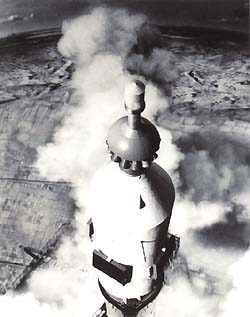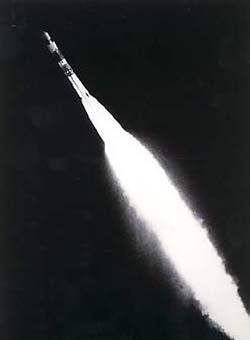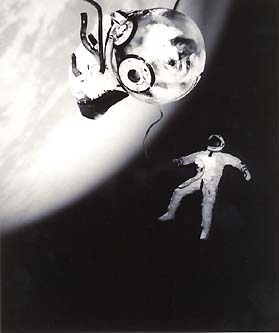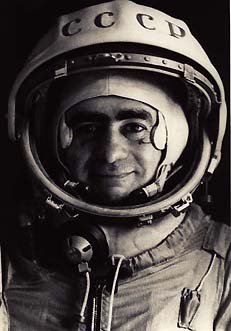21 May through 20 July
Reviewed by Elena Ruano
 Art and Technology
Foundation (Fundacion Arte y Tecnologia), in
collaboration with Moscow Sputnik Foundation, is presenting in Madrid a show of
unpublished and unheard-of
data about previously unknown space research in the former
USSR. Photographs, voice records, original handwriting
texts, navigation instruments, personal belongings and a
video are displayed at the exhibit that also includes a
replica of the original spaceship Soyuz 2. All this material
has an extraordinary documentary and scientific value,
besides the poetic dimension that is always implied in space
exploration. Doctor Olga Kondakova, the director of
the Sputnik Foundation, was at the opening party last 21 May
1997. The current exhibit will be open through 20 July.
With this show theSputnik Foundation has sought to
review one of the most remarkable events in the history of
space exploration.
Art and Technology
Foundation (Fundacion Arte y Tecnologia), in
collaboration with Moscow Sputnik Foundation, is presenting in Madrid a show of
unpublished and unheard-of
data about previously unknown space research in the former
USSR. Photographs, voice records, original handwriting
texts, navigation instruments, personal belongings and a
video are displayed at the exhibit that also includes a
replica of the original spaceship Soyuz 2. All this material
has an extraordinary documentary and scientific value,
besides the poetic dimension that is always implied in space
exploration. Doctor Olga Kondakova, the director of
the Sputnik Foundation, was at the opening party last 21 May
1997. The current exhibit will be open through 20 July.
With this show theSputnik Foundation has sought to
review one of the most remarkable events in the history of
space exploration.
1968: 25 October. From the Baikonur base the Spaceship Soyuz 2 takes off with the cosmonaut Colonel Ivan Istochnikov onboard. The ship was to join, the next day - 26 October - the Soyuz 3 piloted by Colonel Giorgi Beregovoi. It was just an assembly exercise, pure routine: however nothing happened as expected,
At that time both America and the USSR were competing to
land on the moon. Political pressure was strong and there
had already been some victims of their space research.

The Soyuz I flight started with troubles and ended up in tragedy, Commandant Komarov crashed - dying of course - when his parachute failed to open properly.
However, for the Soyuz 2 mission, caution had been extreme and a successful and happy conclusion was anticipated.
After a failed attempt, both ships - Soyuz 2 and Soyuz 3 - lost contact. When they met again the next day, Commandant Istochnikov was missing and his spaceship appeared to have been struck by a meteor.
This mystery was immediately hushed up. Soviet authorities didn't want a new scandal and they made up a typical Soviet style announcement : merely broadcasting that the spacecraft was unmanned.
In order to avoid any conflict with the official version, the cosmonaut's family was confined, his mates were blackmailed to keep from talking, records were changed, photographs manipulated and any other existing documents or information that might be dangerous were destroyed.
Everything was readjusted to fit this new version. The truth of the matter was that reality, in this case, surpassed science fiction.
Years passed and "perestroika" finally came to USSR.

Old secret documents came to light and researchers were finally permitted to figure out what had really happened.
In consideration of all this new data, the Sputnik Foundation comissioned Piotr Muraveinik to prepare the script for an itinerant exhibit. An exhibit whose main purpose would be to spread the truth about this tragic and passionate episode in cosmonautic history. (Piotr was the researcher responsible for cosmonautic issues at the Izvestia investigation center).
The show, now displayed in Madrid at the Art and Technology Foundation of Telefonica depicts this event in space history.
The introductory text of the catalog, includes these words by the writer Saint-Exupery:" ... it's that simple. we just can see properly through the heart. The real truth, the essence of things is invisible to our eyes ...
And that is exactly what the photographer Joan Fontcuberta wants us to took at ...
The show consists of 22 images depicting Commandant Ivan in his training exercises; just before leaving Earth; inside the ship Soyuz 2 in the middle of space with the dog that accompanied him; some photos shot from Soyuz 3 while manoeuvering to join Soyuz 2 - an SOS sent through space in a bottle.
Besides this photographic material there is much physical evidence, both original and replica.
6 windows contain information useful for understanding
these space trips; navigation maps, travel schedules,
diagrams: data analysis about the geological makeup of the
meteor Kadok (the meteor that crashed into the ship) along
with images and photos of its surface.

Other objects such as photographic equipement the pilot used, vinyl long playing records, a representative selection of the astronaut's diet. Even a piece - original, not a replica - of the meteor (displayed into a special window, in order to maintain required temperature and light conditions) that the commandant found in his journey...
There are other valuable documents, very useful for our understand ofcosmonauts training, their physical and psychological preparation, more navigation maps and space diagrams,lab tests, even the dogs' bones, that were submited to these tests, A video, broadcast at the time by the national soviet TV, and the Soyuz 2 ship model (in real size) complete the show. Music from that time is plays in the rooms, to keep us in atmosphere of this period.
An impressive exhibit, due certainly to the accuracy of the documents, the quality of the photographic images and the interesting plot - but, impressive most of all, remembering Saint-Exupery's words, when we consider the fact that the whole show is a fiction, the photographer's version of what might have happened (but didn't) in this episode of space research. Joan Fontcuberta, whose outstanding photographic art may be seen in this show, is also one of Spain's outstanding theoreticians of design and image. His books are an important point of reference for all those who are interested in the "image". He directs the specialised design issues collection "CEAC.$ at Barcelona.
Elena Ruano July 1997, Madrid
JOAN FONTCUBERTA - resume
Born in Barcelona, 1955. He has developed a multidisciplinary career in the photographic field, as a theoretician, photographer, teacher and writer. He has been guest (invited) teacher in different European and American schools. Since 1993 he is a teacher in visual communication School at the Pompeu Fabra University, Barcelona.
He has published several books related to the history and aesthetics of photography: "Una selección de textos", Ed. Blume, Barcelona, 1984. "Fotograf’a: conceptos y procedimientos", Ed. Gustavo Gili, Barcelona, 1990 and "El beso de Judas.Fotograf’a y verdad", Ed. Gustavo Gili,1997 among others. In 1980 he co-founded the Spanish/English magazine Photovision, working as the chief editor.
He has hgad one-person shows at The George Eastman House (Rochester, 1985), Folkwang Museum (Essen, 1987), MOMA,, (NY, 1988), The Photographers' gallery (London, 1988),MIT (Cambridge, 1988), Perspektief (Rotterdam, 1989), Museo de Arte Moderno (Seville,1989), Juana Mord— art gallery (Madrid,1989), MusŽe Cantini (Marsella, 1990), Art Institute (Chicago, 1990), IVAM (Valencia, 1992), Angels de la Mota art gallery (Barcelona, 1992),Parco gallery (Tokyo, 1992), Antoni Estrany (Barcelona, 1993), Zabriskie gallery (Par’s and NY, 1993), Museo de Bellas Artes (Bilbao, 1995), Museum Rupertinum (Salzburg, 1995), Alvar Aalto Museum (Jyvaskyla, Finland, 1995), Forum gallery (Tarragona, 1996), Fundaci—n Arte y Tecnolog’a (Madrid, 1997)
His works are at the MOMA (NY), Metropolitan (NY), San Francisco Museum of Modern Art, Museum of Fine arts (Houston), Los Angeles County Museum of Art, Center for Creative Photography (Tucson), MuseŽ National d'Art Moderne/Centre Georges Pompidou (Par’s),MuseŽ Cantini (Marsella), Folwang Museum (Essen), Museum fźr Kunst und Gewerge (Hamburgo), IVAM (Valencia).
RETURN TO PAGE TOP